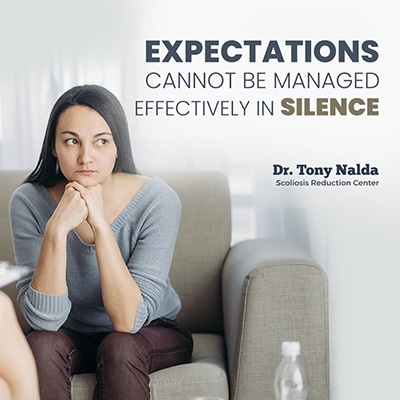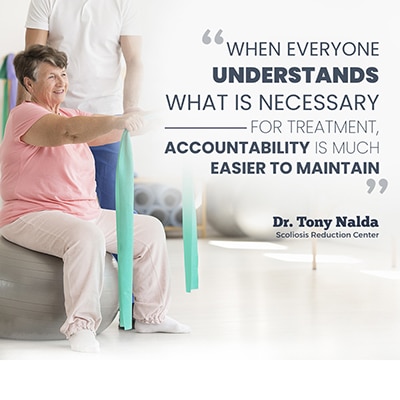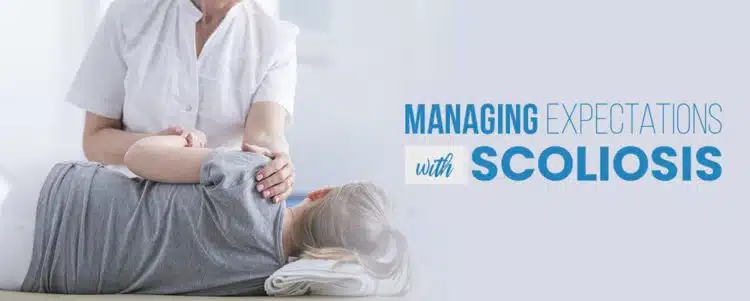One of the keys to treating any medical condition is managing expectations. Successful outcomes are much more likely when everyone is on the same page. This means not only the patient, but family members, loved ones and members of the treatment team.
Unfortunately, “expectation gaps” emerge more often than not when so many different people become involved in the treatment of a condition.
What do I mean by that?
Let’s say an adolescent patient has received a diagnosis of scoliosis. Typically, a parent will spend many hours researching the condition and developing expectations about the possibility of recovery. They will read about the traditional, surgically focused approach to treatment, but they will also spend some time looking at alternative treatments, some of which may be valid, while others are not.
Through this research, they will develop expectations. They may be overly skeptical and assume that surgery is inevitable, and that alternative treatment methods are not worth pursuing. Or they may be overly optimistic and expect that their child will miraculously recover and resume normal activity within a very brief time frame. Because there is so much information to wade through, particularly online, the range of possible expectations is very wide!
Meanwhile, the adolescent patient is hearing anecdotal accounts from their peers about older siblings with the condition, or they are talking to classmates who live with scoliosis. They may even perform their own research into the condition. Along the way, they will develop expectations of their own. However, where the parent is likely looking at the condition from a longer-term perspective, the adolescent patient may be more focused on how the condition will impact their social standing in the here and now. Or they will focus on their ability to participate in activities they love.
At the same time, medical professionals are developing their own expectations based on viewing X-rays, analyzing the patient’s medical history and creating their own assessments. Under the traditional treatment model, a number of specialists may become involved in the care of the patient, which only multiplies the number of different expectations that are involved.
Additionally, friends, family members and others bring their own expectations to the table — and almost no one is on the same page!

This is just one possible example; expectation gaps emerge all the time when dealing with scoliosis. But I don’t think it has to be this way.
The Power of Open Communication
Expectations cannot be managed effectively in silence. Communication is the key to ensuring success, regardless of the treatment path that’s taken.
In my practice, I regard the setting and managing of expectations as a serious responsibility. After all, scoliosis is my specialty, so it is my duty to ensure that patients, parents and loved ones understand the condition.
Here are some of the factors I discuss with patients and parents to ensure that we are all on the same page:
- What Is Scoliosis? I cannot simply assume that everyone knows what scoliosis is, so I describe the condition as plainly and clearly as possible. This explanation establishes a baseline of understanding.
- How Has the Scoliosis Progressed? Once everyone understands what scoliosis is, it’s important to understand exactly how it is impacting that particular patient. Scoliosis is a progressive condition; it does not remain static. So it’s critical for me to communicate the level of progression and curvature that exists. I also tell patients and parents about the risk of further progression and the rate at which it is likely to occur.
- What Is the Patient Capable of Now? It is crucial to assess the strength and flexibility of the spine upon diagnosis. In order to treat scoliosis effectively, everyone involved needs to understand the reality of the condition as it affects the individual patient. Two patients could have identical curvatures, yet the appropriate treatment approach could differ significantly based on each patient’s current capabilities, flexibility and strength level.
- What Does Treatment Look Like? This is very important. When I develop a plan for treatment, I ensure that patients and parents understand what the course of recovery will look like. When everyone understands what is necessary for treatment, accountability is much easier to maintain. As I describe the treatment plan, I communicate the “what,” but I also describe the “how” and “why” of treatment. There should be no mystery regarding the reasons for a particular treatment approach.
- Do You Have Questions? Some patients and parents have pages and pages of notes, concerns and questions. Others only have one or two questions. Regardless, open communication is a two-way street, so once I have shared what I know, I open the floor to patients and parents to ask questions, raise concerns or just tell me how they feel about moving forward.

What Can the Average Patient Expect?
Of course, I cannot speak for doctors and other medical professionals who represent the traditional model of treatment; I can only speak for myself and the treatment approach that I believe in. But if a patient becomes interested in the chiropractic-centered, functional approach to treatment, I want them to know what can be reasonably expected.
Obviously, every patient is different, but generally speaking, this is what I want patients, parents and others to understand about my approach:
- I cannot “cure” scoliosis. My patients have achieved some amazing results, but my approach to treatment does not “cure” the condition. However, I am capable of stabilizing the spine and reducing abnormal curvatures using the functional approach.
- My goal is to prevent scoliosis from worsening. Being “scoliosis-free” is not the goal of treatment. This is not as dismaying as it may sound. Consider those who live rich, full lives with high blood pressure or diabetes: They have not cured their conditions, but they have prevented them from getting worse. My patients also live rich, full, active lives. They see noticeable improvements that allow them to be their best selves with a minimum of lifestyle restrictions.
- Treatment takes time. In most cases of scoliosis, the condition has been present in the body for several years. Achieving reductions in abnormal curvatures does not happen quickly, but it happens. It’s also important for people to understand that adapting to reduced curvatures takes time, as well. Patients need to learn how to live with their improving spinal curvatures. They also need to understand that the brain, muscles and other parts of the body require adjustment. It can be a long and sometimes grueling process, but to me it is far more attractive than the realities of dealing with surgery.
What Are Your Scoliosis Expectations?
Knowing what to expect after a scoliosis diagnosis is important. It’s even more important to ensure that you are on the same page with your doctor and other professionals who may be involved in treatment.
Because the Scoliosis Reduction Center® provides a comprehensive treatment approach, it’s easier for me to ensure that my patients and I are always aligned when it comes to expectations. We provide chiropractic care, of course, but we also guide patients through a process that includes physical therapy, custom bracing and scoliosis-specific exercises. Our patients find it easy to manage expectations because they aren’t traveling from specialist to specialist. They are also kept in the loop about the realities of their treatment — lines of communication are always kept open!
If you’re interested in learning more about scoliosis expectations or the nature of chiropractic-centered treatment, I encourage you to give our office a call today at 321-939-2328.





